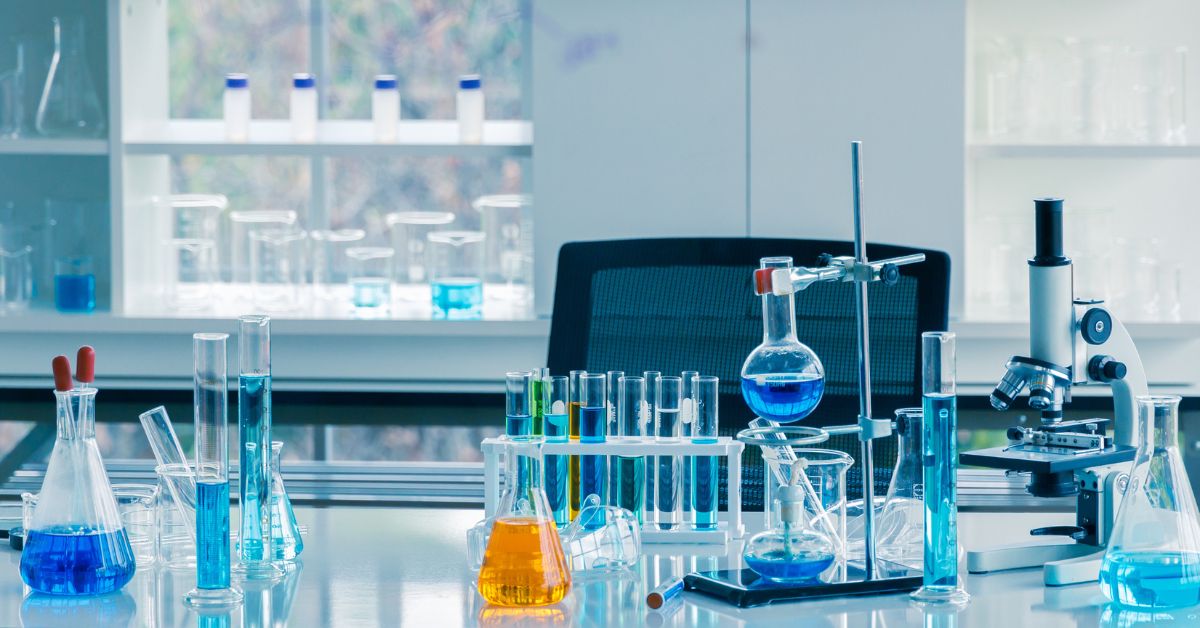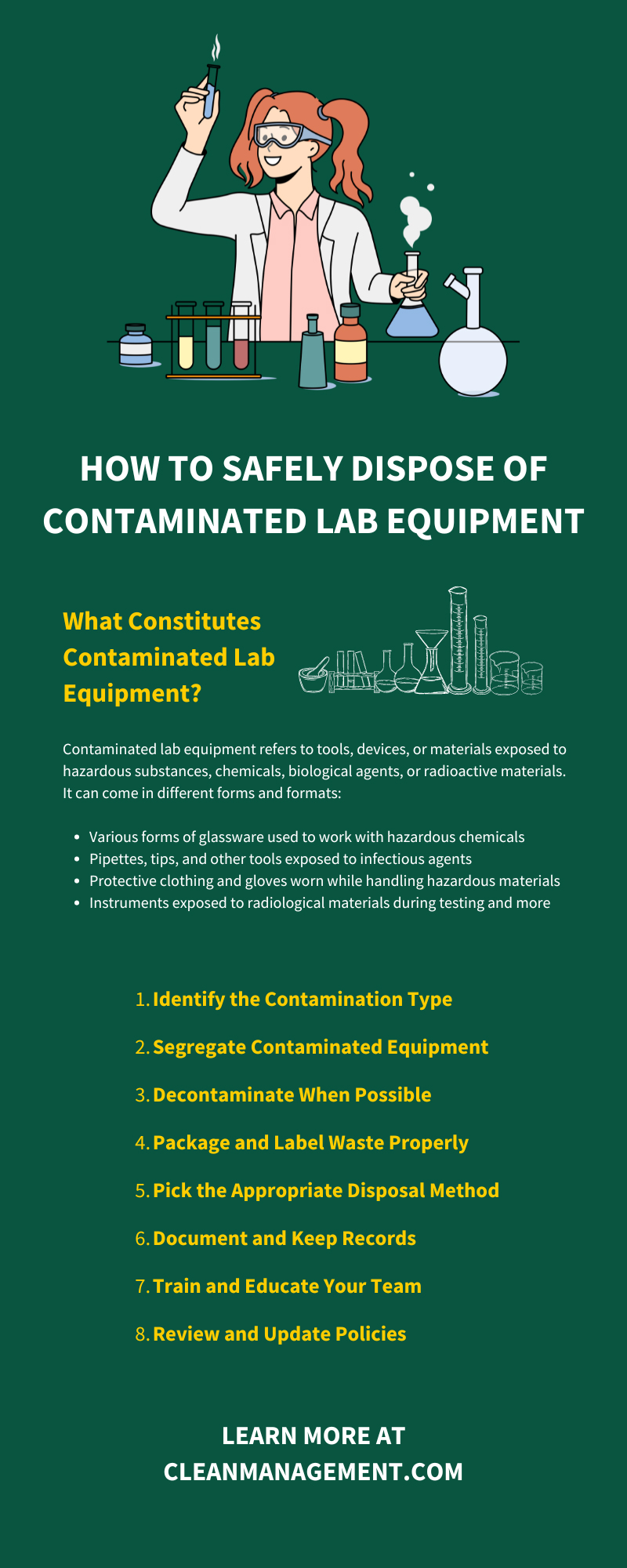How To Safely Dispose of Contaminated Lab Equipment

When laboratory equipment has served its purpose, it’s time to say goodbye. Lab equipment isn’t everyday trash, and you can’t just send it to a landfill. Depending on its previous use, it could contain chemicals and other hazardous substances that may enter the soil, water supply, or air. Your team should take steps to protect themselves from hazards and comply with local, state, and federal waste disposal regulations. Improper disposal methods can risk life, limb, and legal issues. To avoid that, learn how to dispose of contaminated lab equipment safely.
What Constitutes Contaminated Lab Equipment?
Contaminated lab equipment refers to tools, devices, or materials exposed to hazardous substances, chemicals, biological agents, or radioactive materials. It can come in different forms and formats:
- Various forms of glassware used to work with hazardous chemicals
- Pipettes, tips, and other tools exposed to infectious agents
- Protective clothing and gloves worn while handling hazardous materials
- Instruments exposed to radiological materials during testing and more
Proper handling and disposal of these items can prevent contamination and ensure safety for everyone inside and outside the lab who might encounter them. Note the following steps to dispose of contaminated lab equipment safely.
Identify the Contamination Type
Before proceeding with the disposal process, determine the type of contamination. Then, you can figure out the best disposal methods and protective measures. Common contamination types include chemical, biological, or radiological.
Segregate Contaminated Equipment
Next, segregate the contaminated equipment based on the contamination type. Use clearly labeled bins or containers to prevent cross-contamination and reactivity, and store each type of waste separately in different containers or rooms. Segregation is crucial for subsequent handling and disposal steps and creates a safer immediate environment.
Decontaminate When Possible
When feasible, decontaminate the equipment before you dispose of it. Decontamination reduces potential hazards and may make it easier to dispose of equipment and tools. However, decontamination methods vary based on the type of waste. For instance, you can clean chemically contaminated items with neutralizing agents and solvents. Biologically contaminated materials require stronger sterilization methods, such as autoclaving or cleaning with chemicals that kill microorganisms. Radiologically contaminated items, on the other hand, require stricter and more specialized procedures such as isolation and decay storage.
Package and Label Waste Properly
Packaging and labeling are essential for the safe transport and disposal of contaminated equipment. Use containers specifically designed for hazardous waste, ensuring they are leak-proof and resistant to the contamination type. You might use sharps containers, bright red disposal bags, or lab-packing barrels. Label each container clearly, indicating the type of contamination, date of disposal, relevant hazard symbols, and contact information for your lab.
Pick the Appropriate Disposal Method
This decision has probably already been made for you! Disposal methods depend on the contamination type, local and national laws, and industry standards. Here are several common methods of disposal and destruction.
Chemical waste requires neutralization or incineration. It’s best to enlist and contract a certified industrial disposal service provider to help you comply with regulations. Biological waste typically demands sterilization through autoclaving and/or other methods before being incinerated and possibly sent to a landfill. It is imperative to comply with local biohazard disposal protocols.
Radiological waste absolutely cannot be just tossed in the bin. It requires special handling and long-term storage until the radioactivity decays, which may take years, if not decades. This method demands collaboration with a certified radiological waste disposal service.
Documentation and Record-Keeping
Maintaining accurate records of the disposal process is vital for worker safety, regulatory compliance, and potential review by government entities. Always document the types and quantities of waste you dispose of, the disposal methods you use, the dates of disposal, and certifications received from disposal companies. Thorough documentation demonstrates compliance and supports future audits or inspections of your lab.
Training and Education
Employee safety and education are important for keeping everyone safe. Ensure all employees, especially lab personnel, are trained in waste disposal to maintain a safe working environment. Regularly conduct training sessions, emphasizing the importance of understanding contamination types, their dangers, and their respective disposal methods. Training sessions should include the following:
- Teach employees how to recognize different types of contamination and understand the risks associated with each.
- Familiarize people with personal protective equipment (PPE) and its correct usage during the handling, decontamination, and disposal processes.
- Educate staff on emergency protocols for accidental exposure or spills of hazardous materials.
- Stress the importance of accurate documentation and the role it plays in regulatory compliance and operational transparency.
By promoting awareness and continuous education, lab managers minimize the risk of accidents and encourage staff members to handle contaminated lab equipment responsibly.
Review and Update Policies
Regular reviews and updates of waste disposal policies are essential for adapting to new regulations and technological advancements. Establish a routine, annually or bi-annually, for comparing your disposal procedures to the latest guidelines from regulatory bodies such as the Occupational Health and Safety Administration (OSHA), the Environmental Protection Agency (EPA), or local health departments. This review process should include the following:
- Assess the effectiveness of current procedures, and identify areas for improvement.
- Stay atop the news and literature, and keep informed about changes in local, state, or federal regulations affecting waste disposal methods.
- Explore new technologies in cleaning, sterilization, and documentation that could enhance safety and efficiency in the decontamination and disposal processes.
- Gather feedback from lab staff, environmental health professionals, and disposal partners to identify potential gaps and areas for enhancement.
Committing to regular policy reviews ensures compliance and improves operational efficiency and sustainability.
Collaboration With Certified Disposal Partners
We must stress the importance of collaborating with certified waste disposal partners to dispose of your used lab equipment. Here are some things to consider if you’re still on the fence:
- Professional disposal service providers are well-versed in current regulations and help labs stay compliant.
- Trained experts can manage disposal processes from pickup to final destruction, ensuring safe and efficient handling at every stage.
- Hiring professional services reduces the risk of improper disposal, which could lead to environmental contamination or non-compliance penalties.
- Your facility may not be equipped to handle waste internally, but the pros have the means.
When selecting a disposal partner, conduct thorough evaluations by checking credentials, requesting their compliance history, and seeking customer references to ensure reliable and quality service. Now you know how to safely dispose of contaminated lab equipment! Contact us for more details and a consultation on how we can help you maintain a safe and compliant laboratory environment.

